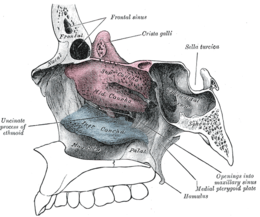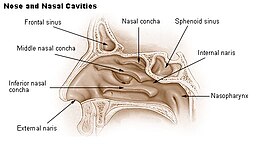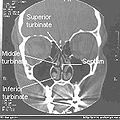Nasal concha
| Nasal concha/turbinate | |
|---|---|
 Lateral wall of nasal cavity, showing ethmoid bone in position. (Superior and middle in pink, and inferior in blue.) | |
 | |
| Details | |
| Identifiers | |
| Latin | conchae nasales |
| MeSH | D014420 |
| FMA | 57456 |
| Anatomical terms of bone | |

In
In humans, the conchae divide the nasal airway into four groove-like air passages, and are responsible for forcing inhaled air to flow in a steady, regular pattern around the largest possible surface area of nasal mucosa. As a ciliated mucous membrane with shallow blood supply, the nasal mucosa cleans and warms the inhaled air in preparation for the lungs.
A rapidly dilating arteriolar circulation to these bones may lead to a sharp increase in the pressure within, in response to acute cooling of the body core. The pain from this pressure is often referred to as "
Structure
Conchae are composed of
The superior conchae are smaller structures, connected to the middle conchae by nerve-endings, and serve to protect the olfactory bulb. The superior conchae attach to the ethmoid bone. The openings to the posterior ethmoidal sinuses exist under the superior meatus.[3] The sphenoid sinus ostium exists medial to the superior turbinate.[5]
The
The inferior conchae are the largest turbinates, can be as long as the index finger in humans, and are responsible for the majority of airflow direction, humidification, heating, and filtering of air inhaled through the nose.[3]
The inferior conchae are graded 1–4 based on the inferior concha classification system (known as the inferior turbinate classification system) in which the total amount of the airway space that the inferior concha takes up is estimated. Grade 1 is 0–25% of the airway, grade 2 is 26–50% of the airway, grade 3 is 51–75% of the airway and grade 4 is 76–100% of the airway.[7]
There is sometimes a pair of supreme conchae superior to the superior conchae. When present, these usually take the form of a small crest.
Function
The conchae comprise most of the
The nasopulmonary and nasothoracic
The conchae are also responsible for
Immunological role
The
Smell
The conchae provide, first and foremost, the humidity needed to preserve the delicate olfactory epithelium, which in turn is needed to keep the olfactory receptors healthy and alert. If the epithelial layer gets dry or irritated, it may cease to function. This is usually a temporary condition but, over time, may lead to chronic anosmia.[4] The turbinates also increase the surface area of the inside of the nose, and, by directing and deflecting airflow across the maximum mucosal surface of the inner nose, they are able to propel the inspired air. This, coupled with the humidity and filtration provided by the conchae, helps to carry more scent molecules towards the higher, and very narrow regions of the nasal airways, where olfaction nerve receptors are located.[3]
The superior conchae completely cover and protect the nerve axons piercing through the
Clinical significance
Dysfunction
Large, swollen conchae, often referred to clinically as turbinates, may lead to blockage of nasal breathing.
Treatment of the underlying allergy or irritant may reduce turbinate swelling. In cases that do not resolve, or for treatment of
Surgery
In the case of
Other animals
Generally, in animals, nasal conchae are convoluted structures of thin bone or cartilage located in the
Animals with respiratory turbinates can breathe faster without drying out their lungs, and consequently can have a faster metabolism.
The bones of nasal turbinates are very fragile and seldom survive as fossils. In particular none have been found in fossil birds.
See also
Additional images
-
Nasal conchae: Blocked/free
-
Normal Nose CT Front cross section
-
Coronal section of nasal cavities
-
Right nasal airway passage
-
Nasal conchae
-
Nasal concha
Notes
- ISBN 978-0-12-811837-5.
In man, the three conchae define the meatuses: Inferior meatus: between inferior concha/turbinate and floor of nasal cavity; Middle meatus: between middle concha/turbinate and inferior concha; Superior meatus: between superior concha/turbinate and middle concha.
- S2CID 79294211.
- ^ a b c d e f Anatomy of the Human Body Archived 2013-01-21 at the Wayback Machine Gray, Henry (1918) The Nasal Cavity.
- ^ a b c d e f Turbinate Dysfunction: Focus on the role of the inferior turbinates in nasal airway obstruction. Archived 2006-06-22 at the Wayback Machine S.S. Reddy, et al. Grand Rounds Presentation, UTMB, Dept. of Otolaryngology
- S2CID 20061049.
- S2CID 5720770.
- S2CID 34156218.
- ^ a b Reduction/Removal of the Inferior Turbinate From the Sinus Info Center.
- ^ Houser SM. Surgical Treatment for Empty Nose Syndrome. Archives of Otolaryngology Head & Neck Surgery\ Vol 133 (No.9) Sep' 2007: 858–863.
- ^ a b Zimmer, C. (1994). "The Importance of Noses". Discover. 15 (8).
- S2CID 39880287.
- ^ a b c Wang (2008) p. 88.
- ^ a b Wang (2008) p. 87.
- ^ PMID 28568303.
- ^ .
- ^ .
- S2CID 7328047.
- ^ Brink, A.S. (1955). "A study on the skeleton of Diademodon". Palaeontologia Africana. 3: 3–39.
- ISBN 978-0-12-404120-2.
- S2CID 89393753.
- PMID 7778882.
- doi:10.1126/science.278.5341.1267.)
{{cite journal}}: CS1 maint: multiple names: authors list (link - S2CID 84693210.)
{{cite journal}}: CS1 maint: multiple names: authors list (link - PMID 5965973.
- PMID 5133493.
- S2CID 32082759.
- S2CID 38947951.)
{{cite journal}}: CS1 maint: multiple names: authors list (link - ^ Maryańska, T. (1977). "Ankylosauridae (Dinosauria) from Mongolia". Palaeontologia Polonica. 37: 85–151.
References
- ISBN 9780231509435.






